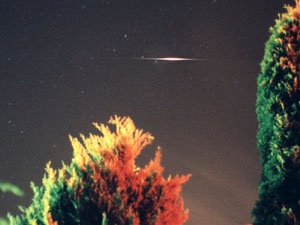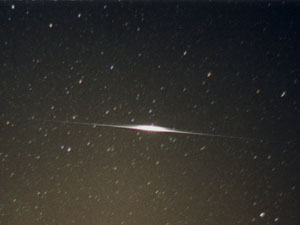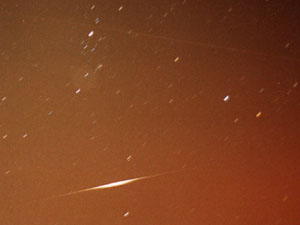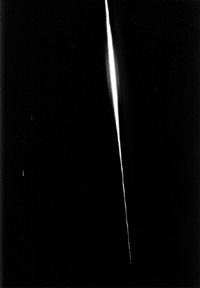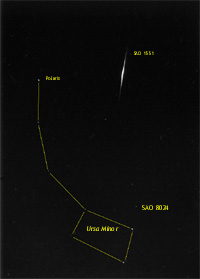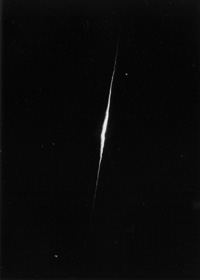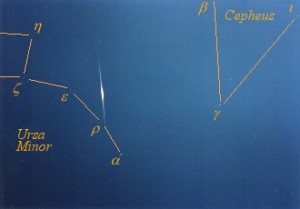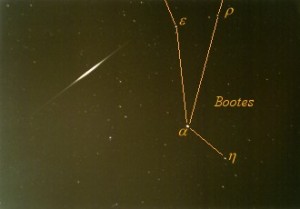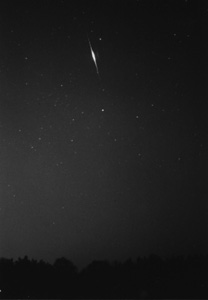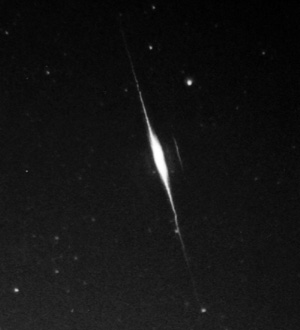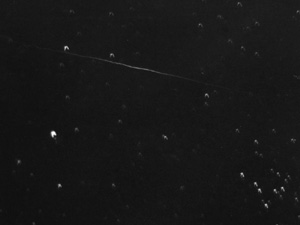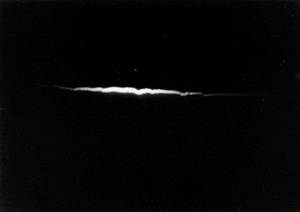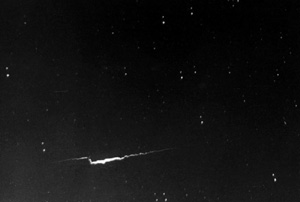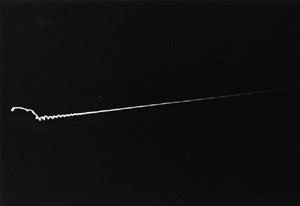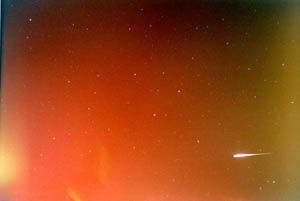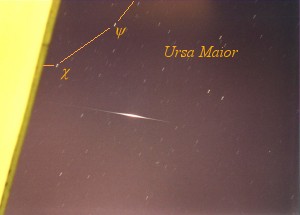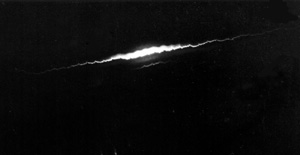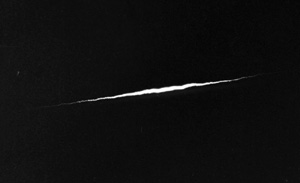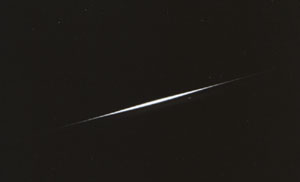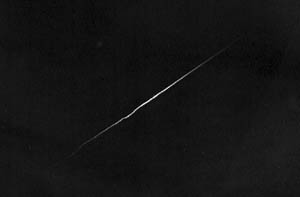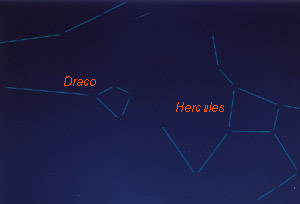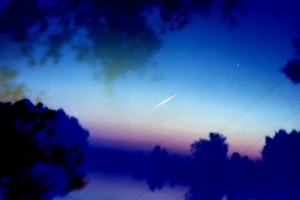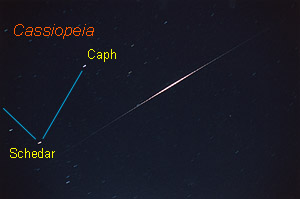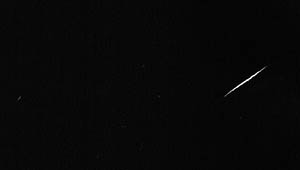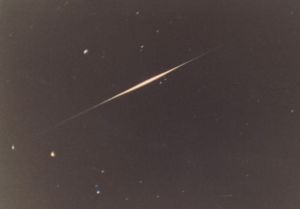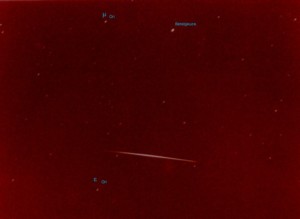| English index |
| Gallery |
| Czech pages |
| Iridium
31
date (d.m.y): 31.8.1999 time:
21:31:21
azimut:
74o, elevation: 47orange: magnitude: -8,1 observe from: Zlín The trees are lit from the road on the left; I sometimes call the picture IFO – “identified flying object”. author: Miroslav PAVEL |
|
|||
| Iridium
28
date (d.m.y): 6.9.1999 time:
21:04:26
azimut:
87o, elevation: 53orange: magnitude: -8,2 observe from: Zlín Extremely bright iridium under the Lacerta constellation (i.e. bright blue stars descending slightly to the right over the iridium). Beautiful colours of the stars can be observed; these are invisible to the naked eye since the waning light makes us see black-and-white (check on the familiar colours during dusk). The camera is, however, able to record the light and make the colour scale evident. Unfortunately, the effect is harmed by the rotating starry sky. author: Miroslav PAVEL |
|
|||
| Iridium
37
date (d.m.y): 6.9.1999 time:
22:20:14
azimut:
47o, elevation: 20orange: magnitude: -6,7 observe from: Zlín This photograph is marked by the orange light of lampposts. There is an aeroplane which had passed through at the upper part of the picture (thin line). The brightest star of the picture is Mirfak of the Persea constellation, followed by the bright of Algol of the same constellation. author: Miroslav PAVEL |
|
|||
| Iridium
83
date (d.m.y): 3.12.1999 time:
5:19:17
azimut:
349o, elevation: 41orange: magnitude: -8 observe from: Zlín I had been waiting for this for such a long time. Two very bright iridiums in two-minute sequence (the second one, Iridium 86, passed at 5:21:38). In fact, I was struck by their closeness. From the beginning I longed to match them both in a range of vision. It is usually hard to see whether the flare showed predicted magnitude. However, one can tell from this picture that the iridiums flare was not equal in spite of the predicted magnitude 8 for both. author: Miroslav PAVEL |
|
|||
| Iridium
57
date (d.m.y): 3.2.2000 time:
19:01:10
azimut:
24o, elevation: 41orange: magnitude: -7,8 observe from: Sezimovo Ústí My very first picture of an iridium flare. I used the F 180 lens and I think the photograph has come out really good. Notice the interesting sides flare at the brightest part of the photo caused probably by the overexposure of negative. author: Martin Klíma |
|
|||
| Iridium
04
date (d.m.y): 2.3.2000 time:
19:01:10
azimut:
24o, elevation: 41orange: magnitude: -7,8 observe from: Sezimovo Ústí Iridium flare track in the picture of the starry sky. Polaris and Ursa minor to the left. author: Martin Klíma |
|
|||
| Iridium
04
date (d.m.y): 2.3.2000 time:
19:01:10
azimut:
24o, elevation: 41orange: magnitude: -7,8 observe from: Sezimovo Ústí This is a detailed shot of the preceding flare. author: Martin Klíma |
|
|||
| Iridium
9
date (d.m.y): 21.3.2000 time:
19:08:58
azimut:
2o, elevation: 43orange: magnitude: -7 observe from: České Budějovice Iridium 9 on the bluish sky not far from Polaris (magnitude 2). At the minilab I was asked which filter I had used ?. The filter was provided by the Nature represented by the Sun sinking under the horizon. Attention, the preview is upside down. author: Martin Gembec |
|
|||
| Iridium
61
date (d.m.y): 25.3.2000 time:
5:18:58
azimut:
218o, elevation: 55orange: magnitude: -5 observe from: České Budějovice There is a rather bright flare shining next to one of the brightest stars of the sky, alfa bootis, Arctura (magnitude 0,0). I did not get to bed until 6 am. author: Martin Gembec |
|
|||
| Iridium
42
date (d.m.y): 6.4.2000 time:
20:54:58
azimut:
356o, elevation: 28orange: magnitude: -4 observe from: Sezimovo Ústí I succeeded to take a flare low above the horizon so as to make the wood part of the picture composition. On the same spot there could have been polar lights seen few minutes after. author: Martin Klíma |
|
|||
| Iridium
42
date (d.m.y): 6.4.2000 time:
20:54:58
azimut:
356o, elevation: 28orange: magnitude: -4 observe from: Sezimovo Ústí Detailed shot of the preceding flare. The vast difference in the brightness of the flare is caused by the overexposure of negative. The sides glare is either lens reflection or it created by another way unknown to me. The same effect as in the first picture. author: Martin Klíma |
|
|||
| Iridium
72
date (d.m.y): 6.4.2000 time:
21:08:27
azimut:
90o, elevation: 53orange: magnitude: -0,1 observe from: Sezimovo Ústí Next Iridium followed 14 minutes after. One can see the flare was rather mild, still it could have been exposed. Notice the interesting shape of exposed stars inexplicably resembling little boomerangs. The camera was placed at the tripod, however, all the time I held the release with my finger. That is most likely the cause, nevertheless, why such shapes? author: Martin Klíma |
|
|||
| Iridium
14A
date (d.m.y): 6.4.2000 time:
21:14:41
azimut:
91o, elevation: 57orange: magnitude: -2,5 observe from: Sezimovo Ústí Picture taken with F180 lens; later on we detected its defect of infinity focus. We discuss the question of the flare irregular shape. author: Michal Moravec |
|
|||
| Iridium
14A
date (d.m.y): 6.4.2000 time:
21:14:41
azimut:
91o, elevation: 57orange: magnitude: -2,5 observe from: Sezimovo Ústí The same flare taken with a different camera. We wonder at the shapes of linear flares. Earthquake, I guess :-)) author: Martin Klíma |
|
|||
| Iridium
03
date (d.m.y): 6.4.2000 time:
22:33:50
azimut:
52o, elevation: 24orange: magnitude: -5,3 observe from: Sezimovo Ústí The last flare on this eventful day. The little jump of flare is caused by an utterly unprofessional change of the position of camera during exposure. What a shame! Polar lights that had been raging in our area by then make the lighter background. Unfortunately, it is scarcely visible on the black-and-white material. author: Martin Klíma |
|
|||
| Iridium
03
date (d.m.y): 6.4.2000 time:
22:33:50
azimut:
52o, elevation: 24orange: magnitude: -5,3 observe from: Sezimovo Ústí Iridium 03 was traced by two diverse cameras. This shot was taken by F 300 teleobjective which allows aiming only after you glimpse the flare. Therefore, the beginning of track is marked by the tremble of tripod. The last section of the track is absolutely straight, which proves that in the case of preceding pictures we had unstable tripods or hands. author: Pavel Heroudek |
|
|||
| Iridium
03
date (d.m.y): 6.4.2000 time:
22:33:54
azimut:
52o, elevation: 24orange: magnitude: -7 observe from: České Budějovice On April 6 we organised a magnificent observation of this Iridium from the north staircase of our dormitory. However, the Iridium flew far on the eastern side so that many actually missed it. I nearly did too – I pressed the release only at hearing somebody shout that it was already passing. Moreover, I brushed against the tripod – luckily, it did not have any major consequences. Yet nobody noticed the polar lights that were raging right then. author: Martin Gembec |
|
|||
| Iridium
74
date (d.m.y): 9.4.2000 time:
20:59:35
azimut:
95o, elevation: 60orange: magnitude: -6 observe from: České Budějovice I took the picture of Iridium 74 flare in the Ursa major constellation from the balcony of the dormitory I stay at when in Budejovice studying physics and geography at local Pedagogical faculty of Southbohemian University. author: Martin Gembec |
|
|||
| Iridium
45
date (d.m.y): 15.4.2000 time:
22:13:42
azimut:
63o, elevation: 37orange: magnitude: -8 observe from: Hvězdárna Kleť This photograph was taken from the observatory Klet – I am honoured to work there sometimes as a guide. The wrong estimate of aiming causes the effect of Iridium 45 hflying as if from behind the spruce tree and aiming over Hercules to Shepherd. author: Martin Gembec |
|
|||
| Iridium
22
date (d.m.y): 23.4.2000 time:
21:37:43
azimut:
69o, elevation: 52orange: magnitude: -6,3 observe from: Sezimovo Ústí I did not have a tripod with me, since the place where it was closes on Sundays. I lied down, pressed the camera against my chest, aimed it and stopped breathing. There is a regular sequence of little jumps following the whole track that owe its origin to my heart pulse – next time I will turn it off. author: Martin Klíma |
|
|||
| Iridium
22
date (d.m.y): 23.4.2000 time:
21:37:43
azimut:
69o, elevation: 52orange: magnitude: -6,3 observe from: Sezimovo Ústí The same flare taken with a different camera, this time the tripod was used. Under this track the flight of Iridium 69 had been predicted in ten-second sequence and one-degree deflection – nevertheless, it has not appeared as predicted. The second flare came after 30 seconds in approximate twenty-degree deflection. Satellites may have deviated form their tracks or the discrepancy was caused by an error of calculation. Nothing similar has happened ever since. author: Pavel Heroudek |
|
|||
| Iridium
60
date (d.m.y): 3.5.2000 time:
22:30:30
azimut:
48o, elevation: 34orange: magnitude: -7,4 observe from: Sezimovo Ústí This flare was observed from two posts 60 kilometres far from each other. The discrepancy between maximums was app. 4 seconds. This time I was sure about the right aiming according to the stars. Therefore I used F105 lens and distance release. It paid back in the form of straight track of the flare. author: Martin Klíma |
|
|||
| Iridium
30
date (d.m.y): 11.5.2000 time:
22:00:50
azimut:
55o, elevation: 48orange: magnitude: -3,9 observe from: Sezimovo Ústí We had planned to orientate according to the stars. However, we did not realise there would not be many stars at this time of a day. We are satisfied to have got the flare in a field of vision. author: Pavel Heroudek |
|
|||
| Iridium
58
date (d.m.y): 16.5.2000 time:
21:39:56
azimut:
57o, elevation: 55orange: magnitude: -3,3 observe from: Sezimovo Ústí No authorial comment. The flare is at the top of the picture. author: Pavel Heroudek |
|
|||
| Iridium
61
date (d.m.y): 3.6.2000 time:
22:03:18
azimut:
49o, elevation: 49orange: magnitude: -7,9 observe from: Haklovy Dvory Unplanned yet rather effective double exposition of Mercury and Iridium 61 over the pond water table. author: Martin Gembec |
|
|||
| Iridium
18
date (d.m.y): 4.6.2000 time:
3:14:54
azimut:
294o, elevation: 46orange: magnitude: -7,9 observe from: České Budějovice English comment not available yet. author: Martin Gembec |
|
|||
| Iridium
56
date (d.m.y): 7.6.2000 time:
23:22:08
azimut:
27o, elevation: 21orange: magnitude: -6 observe from: Týnec u Klatov “And this is why you get up in the middle of night – you must be crazy.” I greet all my enthusiastic colleagues by free interpretation of my dear spouse reaction after seeing the result of my endeavour. At about 23:10 the sky slowly clouded over from the east (as one would expect). The Iridium showed close to a cloud and I could have rather enjoyed it. It was not as bad as it was my first try, however, next time I will have to press the release a little earlier. Moreover, the tripod could be more stable, or did I stumble over it? Anyway, I took the picture using Praktica MTL 5, F50 lens, at f 4, 6 secs., Fujicolor 400 ASA. To the left of the flare track Cassiopeia can be seen. author: Rostislav Klemsa |
|
|||
| Iridium
12
date (d.m.y): 9.6.2000 time:
23:10:24
azimut:
30o, elevation: 24orange: magnitude: -6,6 observe from: Sezimovo Ústí Though it is my first coloured photograph of Iridium, it has come out great. The flare was unexpectedly long, I was worried to fit the whole track in a range of vision. Lens approximately F 100 – 120, f 4, 400 ASA. The right part of Cassiopeia is visible on the left. I saw for myself that human eye perceives Iridium earlier then it actually starts exposing to a film: in reality the flare path started under the midst of Cassiopeia and continued further on from the field of vision. author: Martin Klíma |
|
|||
| Iridium
12
date (d.m.y): 9.6.2000 time:
23:10:24
azimut:
30o, elevation: 24orange: magnitude: -6,6 observe from: Sezimovo Ústí Iridium 12 was taken with two cameras. The exposition of wide-range photograph with the view of landscape and observatory did not come out right. This is a part of it. author: Pavel Heroudek |
|
|||
| Iridium
70
date (d.m.y): 16.6.2000 time:
3:12:56
azimut:
128o, elevation: 46orange: magnitude: -8 observe from: Týnec u Klatov The Moon shone bright at that time, so the stars are scarcely visible. author: Rostislav Klemsa |
|
|||
| Iridium
41
date (d.m.y): 27.6.2000 time:
23:33:03
azimut:
23o, elevation: 17orange: magnitude: -6 observe from: Týnec u Klatov The flare is rather long, I somehow did not manage aiming. author: Rostislav Klemsa |
|
|||
| Iridium
10
date (d.m.y): 29.6.2000 time:
21:47:32
azimut:
51o, elevation: 56orange: magnitude: -8 observe from: Sezimovo Ústí The flare followed immediately after the sunfall, therefore the precise aiming was impossible. Just for sure I used wide-range lens. The second coloured try - nothing special. A lot of light remaining in atmosphere rather diminishes the flare magnitude 8. author: Martin Klíma |
|
|||
| Iridium
82
date (d.m.y): 4.7.2000 time:
23:08:00
azimut:
38o, elevation: 31orange: magnitude: -7,1 observe from: Hvězdárna Kleť Iridium picture taken first with Helios 2/58 lens and teleconvertor 2x, but last time with Zenit TTL. The flare was rather long and appeared in the right part of Cassiopeia constellation. author: Martin Gembec |
|
|||
| Iridium
84
date (d.m.y): 26.8.2000 time:
3:51:05
azimut:
95o, elevation: 11orange: magnitude: 0 observe from: Svrčovec u Klatov Many stars up to the magnitude 7 are visible in the picture. The background is, however, light – blame the minilab, I guess. author: Rostislav Klemsa |
|
|||
| Iridium
20
date (d.m.y): 12.5.2001 time:
23:25:04
azimut:
247o, elevation: 33orange: magnitude: -8 observe from: Újezd nad Lesy Photoimage contains both Iridium 20 and 25 flares. author: Filip Maňhal |
|
|||
| Iridium
25
date (d.m.y): 12.5.2001 time:
23:30:51
azimut:
247o, elevation: 32orange: magnitude: -7 observe from: Újezd nad Lesy Photoimage contains both Iridium 20 and 25 flares. author: Filip Maňhal |
|
|||
| Iridium
29
date (d.m.y): 13.5.2001 time:
0:57:36
azimut:
198o, elevation: 46orange: magnitude: -8 observe from: Újezd nad Lesy No comment. author: Filip Maňhal |
|
|||
| Iridium
76
date (d.m.y): 31.5.2001 time:
21:50:32
azimut:
291o, elevation: 13orange: magnitude: -1 observe from: Týnec u Klatov Sorry, english comment is not available yet. author: Rostislav Klemsa |
|
|||
